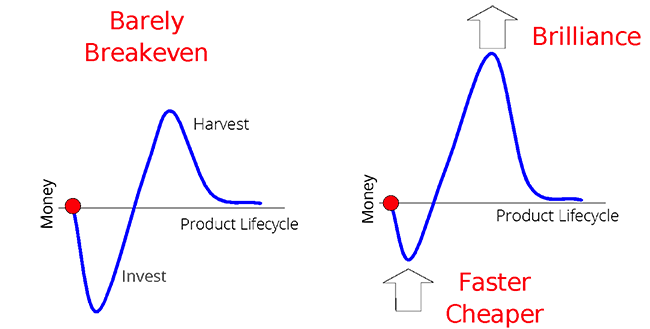
The Rise of the Serial Innovator
We live in one of history’s great eras of opportunity. In the years ahead incredible things will be done in the name of innovation, ultimately replacing an economic system that has been the foundation for employment and wealth for hundreds of years.
There are deep dangers here. Not the least of these is that innovation looks so much like hype. We might be forgiven imagining this is just another consulting fad destined to fade away. That would be a mistake, like pretending a bus that’s about to run you over is just a mirage and will conveniently vanish before crushing you to the pavement.
We are replacing our economic system on a global scale. Despite all the hyperbole filling blogs and boardrooms, most of us still don’t fully grasp the scale of this change. The forces behind it are deep, broad enough to sweep away much of our existing business world.
The last time something of this scale happened was when the current industrial economy replaced agriculture as the key source of value creation in the world. The bus of change is coming on fast. We need to see beyond the hype, understand what’s happening, and discover where our opportunities lie.
Harvesting Assets
Here’s what driving the bold claim that we are living a historic moment of change. The last 200 years of the industrial age were built on this investment curve.
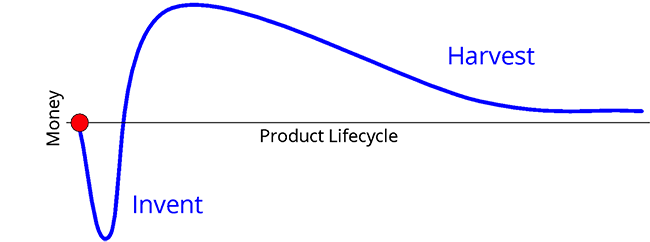
Capital was invested to create a new source of value, after which the owner could spend years harvesting their asset. Because so much more time was spent in the harvest stage, success was tied to operational excellence. Profit flowed from improving efficiency while delivering consistent quality.
It’s a model that permeates our economy. Businesses are built on it and even personal lives follow the curve. We invest in college educations in order to create life long opportunities for harvesting our knowledge.
Four Big Disrupters
What’s undermining this comfortable centuries old curve? Four big trends have come together, creating an unprecedented global capacity to imagine and bring innovation to market.
Exponential Toolkit: In 1965 Gordon Moore posited that number of transistors squeezed onto a computer chip would double every two years. Ray Kurzweil from his seat at MIT extended that proposition. He showed that processing power had been growing at exponential rates since the beginning of 1900.
There’s a deep underlying pattern here. Ideas multiply at exponential rates. Numerous fields such as the number of patents filed, the quantity of genomes scanned, or the pages of writing created (perhaps a measure of the ideas in the world) all seem to follow the same curve.
To put exponential growth in perspective, in a Moore’s Law world, we learn at 1000 times the rate we did 20 years ago. Remarkably, this growth does not seem to be bounded by the limits that constrain bacteria in petri dishes. Our creator’s tool kit just keeps growing.
Falling Cost of Invention: More and better tools mean that the cost of invention falls. A kid can do what used to take an industrial scale research lab to achieve.
It is not a fluke that 20-year-old Palmer Luckey was able to develop the Oculus Rift, a virtual reality product worth $2 Billion dollars, and sell it to Facebook. Or that Facebook, a $200 billion dollar company, was started by another 20-year-old in a college dorm room.
As an innovator’s capital constraints fall, one of the biggest barriers to participating in creative market disruption is removed. Riskier ideas can be pursued because the cost of failure is reduced. Since the burn rate of opportunity discovery is lower, innovators can persist with radical ideas through longer periods of discovery.
Explosion of Creators: Education is finally pouring out of the historically limited confines of developed countries and university classrooms. Every year the ranks of the economically competent grow. 6.7% of the world’s population now have college degrees and by 2020 some 40% of all graduates will come from India and China. A student in Mongolia can four point a class from MIT without ever leaving home.
Florence Italy had just 100,000 people when it was the center of Italian Renaissance. Today many time that number of entrepreneurially minded and passionately driven innovators are swelling the creative world workforce.
Removing Market and Production Barriers: World markets are suddenly giddily accessible, with services for hire across the entire supply chain. Highly configurable technologies make small lots and niche markets possible, removing scale as an implicit barrier to production and distribution.
The Internet of Things is a subject of hype in its own right. Some 16 billion connected devices are stitching themselves into homes, cars, and the street around us. By the end of the decade, 40 billion tiny marketing, sales and distribution channels will be imbedded in our lives. There will be very few walls left around the customer.
Serial Innovation with Dan McClure. Listen to Dan McClure's interview by Johannes Thöenes on SoundCloud. In the podcast he discusses the drivers and impact of a new innovation driven economy.
Accelerating Obsolescence
These changes are irrevocable. There will be no shutting down technology, suddenly reinstating the high cost of innovation, or hiding away an army of educated minds.
But so what? Why is this moment any different than the situation that existed ten, twenty or even thirty years ago? It’s the combination if all four of these drivers together that changes the world.
This ecosystem, operating at a global scale, opens the door for both futuristic market disruptors and hungry opportunistic scavengers.
In their book, Big Bang Disruption, Larry Downes and Paul Nunes, observe that competitors now have the power to enter markets with propositions that are simultaneously better, cheaper and more customized. Anyone who has used Uber in New York City would be hard pressed to find a dimension on which they prefer a traditional yellow cab.
Seth Godin has pointed out that in marketplace filled with ubiquitous choice, no one needs to be satisfied with a number two option. Rivals entering a market don’t just get a slice of the pie; they can take the whole thing. Competitors employing a fast follow strategy can copy winning ideas with ever-greater ease, draining the market of profitability.
The growing power of the innovation ecosystem means that economically devastating change happens faster too. Downes and Nunes found that “Disruptive innovations may have once taken a decade or more to transform an affected industries … that time frame has compressed to half - and continues to shrink.” [Larry Downes and Paul Nunes, Big Bang Disruption, Penguin, 2014, pg. 21]
Accelerating economic obsolescence is the result.
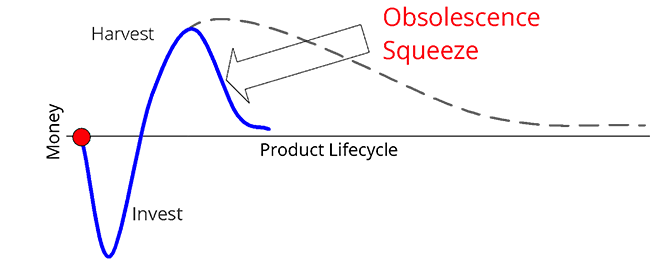
What makes this so devastating is the impact it has on the Industrial age harvesting curve. The opportunity to harvest value from an investment in invention and the time to fine tune its operational delivery are shrinking.
As highly effective competitors enter markets with ever-greater speed, the lifespan of any given idea is compressed. Innovation can still create new market opportunities, but the time an organization or individual has to harvest potential profit falls dramatically. This is the fact that undermines the two century old model for the industrial economy.
The New Business of Serial Innovation
Downes and Nunes call this new product value curve the “shark fin.” A quick look at its shape highlights key realities of the new innovation based economy.
- Cost of delay is high – Market opportunities are short. Delay results in missing both the highest peak of profitability and a significant portion of a compressed product lifespan.
-
Excellence drives return – Improving the value of the innovation allows for higher prices or quicker adoption. Either way, excellence drives the peak of the curve upward.

- Invention must be fast and cheap – The downward side of the curve needs to be as small as possible. Driving down the cost and improving the speed of innovation keeps the cost of invention in line with the shorter lifecycle on the harvest side.
Serial Innovation as a Core Competency
Now we have the basis for a new economic model. Instead of harvesting ideas and fine tuning operational performance over time, there is a need to repeatedly generate new innovations. The new business curve will look something like this.
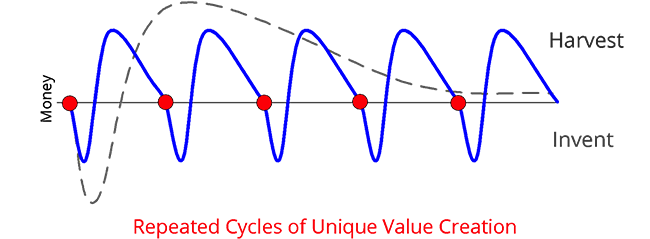
This demands a radically different approach to business. Innovation becomes the new core competency. It is no longer be something to be done as an occasional refresh or as a sideline to marginally grow opportunities. To thrive we will need to:
Repeatedly create unique and original value that matters in the marketplace, quickly and at affordable cost.
In a talk to economic development leaders in Michigan, Richard Florida of Creative Culture fame projected that we were on the cusp of the “biggest economic disruption of all time”. That’s an opinion I whole heartedly support.
What We Don’t Yet Believe or Understand About Perpetual Insurgency
There are three things people fail to understand about this transformation:
The Sheer Scale and Urgency: It's seldom the right choice to throw out beliefs that have been proven in practice for over 200 hundred years, and yet there are moments when transformative shifts do occur. Today, fewer than 1% of Americans work on a farm, and less than half of those makes it their full time job. That’s a future that would have unimaginable to an 18th Century landowner. The industrial model is due for a similar upending. This change is rooted in pervasive fast moving trends. The forces are global in scale and will wash over organizations with surprising speed and devastation. Businesses practices, investment strategies, tools of trade, and organizational culture will be altered across every industry.
A common reaction is to claim this is just a tech industry problem, but there is no safe haven. Taxi drivers, book publishers, pathologists and clothing retailers are all examples of supposedly non-tech businesses being shaken to their core.
Daunting Breadth and Complexity: Today, “innovation” is often limited to small pilots and standalone initiatives, inconsequential baby bunnies with limited business impact. Inventions need far more sophistication and scale to act as the foundation for sustainable business success. Technology will remain a lynch pin for this work, but it won’t be the only tool that matters. Complex innovation draws on diverse skills in strategy, design, change leadership, partnering, evangelism, architecture and more. The job of real innovation is broad and messy. Indicative of the growing plurality of the talent pool, we observe designers in China now commanding substantially higher rates than engineers.
We Are Not Ready: Most of today’s innovation practices are in their infancy. This is a huge challenge, and we are still largely novices, often failing to appreciate the lack of sophistication we bring to the job. There is work to be done in both professional practices and social engineering. Our fundamental understanding of the craft and theory of innovation is still incomplete. We lack a robust vocabulary of ideas, end-to-end techniques, and the necessary new talents in the workforce.
One of the most frequently asked questions during our strategy planning session is “What do we really mean by innovation?” There is a long way to go from that question to building a business that acts as a valid alternative to industrial asset harvesting.
Why I Couldn’t Be More Excited
This is a potentially terrifying future, yet I would not trade my spot in history, standing at a remarkable moment of creative change. Here’s why.
A Chance to Do Great Things: This new economic model is capable of extraordinary things. For all our progress as a global culture over the last two hundred years, there are still an exceptional number of unsolved problems. The world can be a better place with more creative answers. This is an economy that excels at delivering creative answers.
Here’s an example. This prosthetic hand from ROW (Rest of the World) can be printed according to customized digital specifications. Designs are created by an open source community and delivered to a digital printer literally anywhere in the world. There is the potential to build a world of everyday miracles.
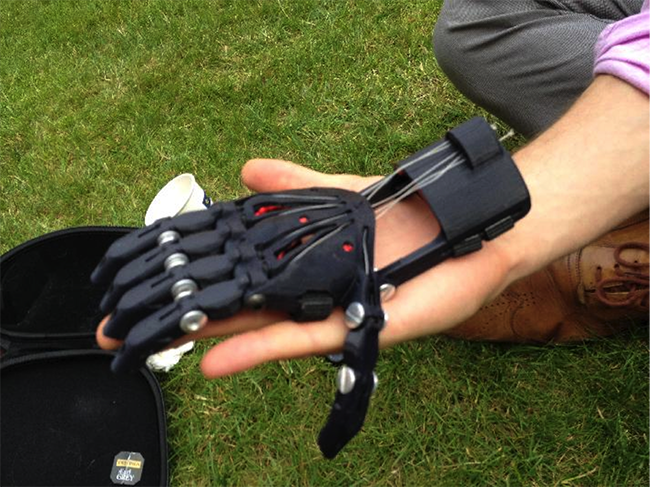
Work Worthy of Our Talents: The industrial model’s harvesting of value builds upon Fredrick Taylor’s pin factory and the skills of repetition. People deserve more than a life filled with repetitive tasks. The skills needed in an innovation economy include creativity, problem solving, collaboration, and passion. These seem like richer life choices offering a better chance to use our unique gifts well.
Growing Democracy of Creative Opportunity: Walls are falling down. Even war torn regions can be (and are) places of creative life.
Hind Holbeika is a professional woman in Lebanon. She leveraged a finalist position in a Middle East TV reality series for young inventors to conceive and design Instabeat, a wearable technology for competitive swimmers. From her home she has led a global design team and drawn on crowd sourced funding to bring an advanced consumer product to market.
The Case in a Nutshell
Here’s a summary of the case for the new capability of serial innovation:
Old Harvesting World: The 200 year old industrial economic model is based on long term harvesting assets and perfecting operations.
Big Trends / Innovation Ecosystem: Four big global trends are creating a new ecosystem of innovation
- Exponential growth of the tool kit
- Low cost invention
- Explosion in the number of people engaged
- Falling barriers to production, marketing and distribution
New Serial Innovation: As the time to harvest investments falls, a new innovation economy emerges:
- Serial innovation – repeated innovation as a core competency
- Excellence – unique and original value that matters to someone
- Speed – delay is particularly costly
Challenges: We often fail to appreciate the scale and complexity of serial innovation’s challenges. There’s a lot of work to do.
Hope: We aren’t ready yet … but there are great possibilities ahead.
Next … Taking a Deeper Dive
This is the first of a series of articles that explores the challenges and opportunities of innovation. The second will provide some structure around that troublesome query, “What is innovation anyway?”
Disclaimer: The statements and opinions expressed in this article are those of the author(s) and do not necessarily reflect the positions of Thoughtworks.















